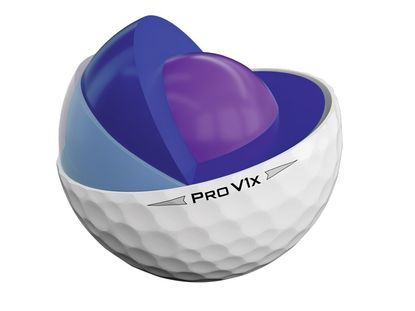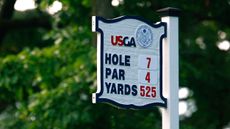What's Inside A Golf Ball?
We explain everything there is to know on what is on the inside of a golf ball.


We explain everything there is to know on what is on the inside of a golf ball.
What's Inside A Golf Ball?
Like every bit of technology in the game of golf, the golf ball has changed remarkably quickly in a pretty short space of time.
There was a time when cutting a golf ball in half would reveal wood or leather but nowadays we are presented with an assortment of colours, materials and thicknesses.
So what exactly is inside a golf ball? Let's take a look.
Well the inside of many golf balls differ in modern golf because brands create a variety of balls for different players, usually dependent on ability.
For example you may hear the terms one-piece, two-piece, three-piece, four-piece, five-piece and even six-piece in relation to balls and this basically references how many layers the ball has.
Get the Golf Monthly Newsletter
Subscribe to the Golf Monthly newsletter to stay up to date with all the latest tour news, equipment news, reviews, head-to-heads and buyer’s guides from our team of experienced experts.
One-Piece Ball
These tend to be for beginners or you will find them commonly at golf ranges because they are the least expensive to produce. Usually these balls are made from one piece of Surlyn plastic and then the dimples are moulded into it.
Two-Piece Balls
This is the ball that most ordinary golfers use and they usually comprise of a large core which is then wrapped in a plastic of some kind. For example one of the most popular is the Srixon AD333 which is in its 10th generation.

Three-Piece Balls
These balls tend to have a solid rubber or liquid core, a thin layer of rubber and then the durable cover. These balls are softer and produce more spin than two-piece balls.
Four-Piece Balls
Going one step further again, are four-piece balls.
The inner core, the first layer, of the ball is the solid rubber centre that is primarily designed to offer distance with a driver. The next, inner cover, layer is in the ball to transfer the energy from the strike to the hot core.
Then there is an extra layer compared to a three-piece balls and finally there is the cover which is the thinnest of the lot to help provide feel. The best example of a four-piece ball is the Titleist Pro V1x which many of the world's best players use.
Five-Piece Balls
Five-piece balls were the next step taken by some brands. Usually the inside of these balls have three thin layers sandwiched between a large core of rubber, and a thin plastic cover.
These balls, like the four-piece, offer the best performance and two good examples of this are the TaylorMade TP5 and TP5x.
Six-Piece Balls
There are also six-piece golf balls like the Honma Future XX which has a soft core and each layer gets gradually firmer and then the sixth layer is the soft outer cover.
Different Types of Cover
When talking about golf balls it is also important to mention covers and the different materials used.
The two main ones are urethane and ionomer which have many differences to them.
Urethane is a polymer that has many attributes that are beneficial for a golf ball, most notably its ability to have its toughness and hardness controlled when heat is applied. Because Urethane can be reheated and re-moulded, it allows for more precision and design flexibility.
Consequently, Urethane can be crafted for a softer feel, and so is normally found in more expensive, premium golf balls. As a result of its softness, Urethane covers should provide more strike feedback off chips and putts, which will help you hone your distance control more easily.
Ionomers do not maintain their strength as well when they are engineered softer, so can be less durable if designed with a soft cover. Ionomer is also cheaper to produce and feels slightly firmer, though it should still provide plenty of feel for most club golfers.
Thanks to their firmer feel, Ionomer cover balls tend to spin slightly less of the tee, helping to reduce unwanted sidespin that can cause destructive hooks and slices. Because of these characteristics, Ionomer covers usually feature on distance and two or three-piece golf balls
For more golf gear content do not forget to follow Golf Monthly on Facebook, Twitter and Instagram.

A golfer for most of his life, Sam is Golf Monthly's E-commerce Editor.
Working with golf gear and equipment over the last six years, Sam has quickly built outstanding knowledge and expertise on golf products ranging from drivers, to balls, to shoes.
He combines this knowledge with a passion for helping golfers get the best gear for them, and as such Sam manages a team of writers that look to deliver the most accurate and informative reviews and buying advice. This takes the form of buying guides, reviews, supporting gear content as well as creating deal content.
This is so the reader can find exactly what they are looking for, at a good price.
Sam now spends most of his time testing and looking after golf gear content for the website, whilst he is also responsible for all content related to golf apparel.
Additionally Sam oversees Golf Monthly voucher/coupon content which seeks to find you the best offers and promotions from well-known brands like Callaway, TaylorMade and many more.
Unfortunately, Sam is not a member of any club at the moment but regularly gets out on the golf course to keep up the facade of having a single-figure handicap.
Sam's What's In The Bag:
Driver: Cobra LTDxLS (9 degrees)
Fairway Wood: Ping G430 Max (15 degrees), Nike Covert Tour 2.0 (19 degrees)
Irons (4-PW): Titleist AP2
Wedges: Titleist Vokey SM7 54˚, 58˚
Putter: Scotty Cameron Phantom X 5.5
Ball: Srixon Z-Star Diamond
Shoes: G/FORE Gallivanter/Nike Air Zoom Victory Tour 3/Cuater The Ringer
(For off the course he goes for Nike Jordan 1 Low G shoes as well)
-
 Do Par 4s Have To Be A Minimum Or Maximum Length?
Do Par 4s Have To Be A Minimum Or Maximum Length?Can a par 4 be 200 yards or 550 yards if so desired? Are there actually any rules that say how long or short 'two-shotters' have to be?
By Roderick Easdale Published
-
 15-Year-Old Miles Russell Receives First PGA Tour Start After Meteoric Rise Up World Rankings
15-Year-Old Miles Russell Receives First PGA Tour Start After Meteoric Rise Up World RankingsThe teenage sensation made history last week by becoming the youngest player to make the cut at a Korn Ferry Tour event
By Joel Kulasingham Published